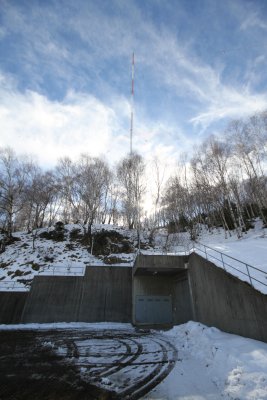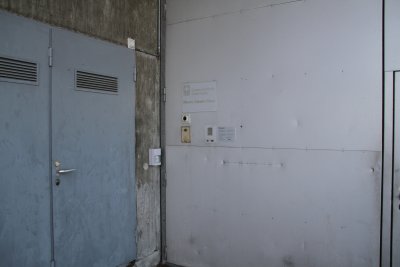
Underground transmitter building.

Transmitter building entrance.
| Location: | E 8° 59' 25.51" / N 46° 08' 19.16" |
| Frequency: | Transmitter is off (used to be 558 kHz). |
| Wavelength: | Transmitter is off (used to be 538 m). |
| Power: | Transmitter is off (used to be 300 kW). |
| Call-sign: | Used to be "Radio Monte Ceneri", then "Radio Svizzera, Rete Uno" (and temporarely "La voce della Russia"). |
| Transmission type: | Medium wave AM broadcast station. |
The transmitter was switched off in December 2012 and both antennas (main and spare) have been dismantled in July 2016.
The Monte Ceneri radio station started operating on April 18, 1933 with a 15 kW Marconi transmitter on 650 m (461 kHz) from the Monte Ceneeri Pass location. In 1934 the frequency was changed to 1167 kHz (257 m). In 1951 the power is increased to 50 kW and the frequency changed to 557 kHz (539 m) according to the Copenhagen plan. In 1967 the power is further increased to 100 kW. At the end of 1978 the frequency is changed to 558 kHz (538 m) to follow the plan of Geneva. In October 1979 the transmitter moved to the Monte Ceneri Cima location (about 6 km to the East) with a new antenna and a new 300 kW transmitter. This station was initially named "Radio Monte Ceneri" and later changed to "Radio Svizzera, Rete Uno". The transmitter was switched off in June 2008. It started transmitting again in January 2011 to broadcast the "Voice of Russia" for a few hours every day and was switched off again in December 2012. Both antennas (main and spare) have been dismantled in July 2016. The transmitter building is still there.
 Underground transmitter building. |
 Transmitter building entrance. |
| Tower type: | 220 m guyed tower. |
| Antenna type: | 0.4λ (144°) vertical tower, isolated from ground. |
| Feed point: | Base of the tower. |
| Ground plane: | 120 buried radials, 200 m long. |
This antenna was built in 1978 and switched on in 1979, replacing the old Monte Ceneri Pass tower (about 6 km West). This antenna was dismantled in July 2016.
When the transmitter is operating one can clearly hear the modulation by standing near where the internal (short) guy wires ere connected to ground. The antenna simulation shows that a very high current is present at this point.
Today this antenna has been dismantled and only little evidence remains of the old structure.
The following pictures show how the antenna looked like in February 2011:
| Tower type: | Cage wires, suspended between two poles. |
| Antenna type: | Short vertical with huge capacitive hat, isolated from ground. |
| Feed point: | Base of the vertical cage. |
This antenna was dismantled in July 2016.
The following pictures show the location in December 2016 after the antenna has been removed.
This is how the antenna looked like in February 2011.